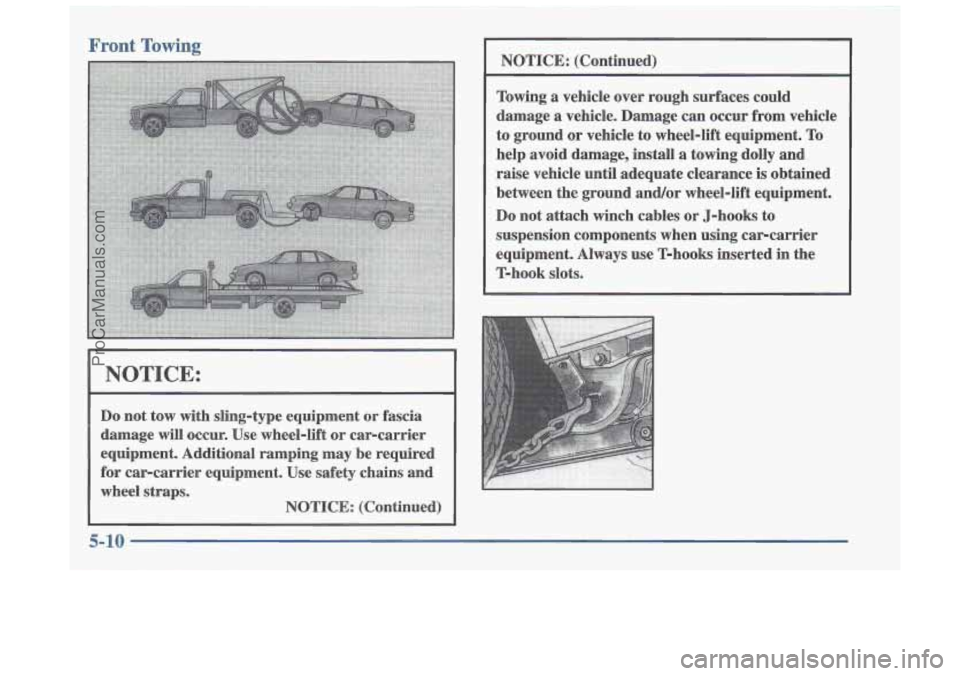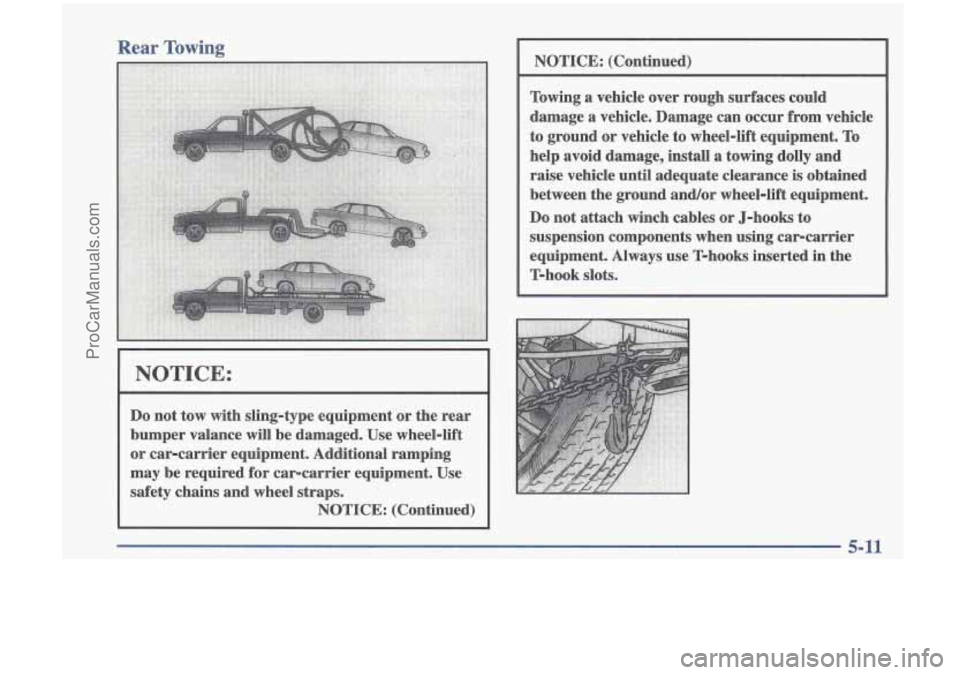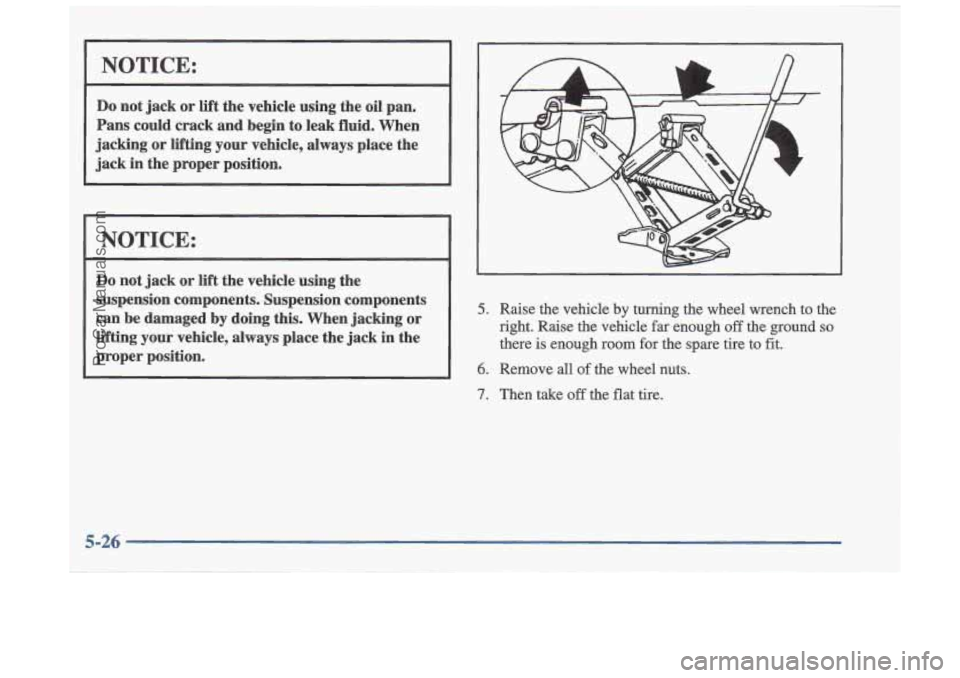1997 OLDSMOBILE CUTLASS suspension
[x] Cancel search: suspensionPage 197 of 353

NOTICE:
Do not tow with sling-type equipment or fascia
damage will occur. Use wheel-lift or car-carrier
equipment. Additional ramping may be required
for car-carrier equipment. Use safety chains and
wheel straps.
NOTICE: (Continued)
NOTICE: (Continued)
Towing
a vehicle over rough surfaces could
damage
a vehicle. Damage can occur from vehicle
to ground or vehicle to wheel-lift equipment. To
help avoid damage, instan
a towing dolly and
raise vehicle until adequate clearance
is obtained
between the ground and/or wheel-lift equipment.
Do not attach winch cables or J-hooks to
suspension components when using car-carrier
equipment. Always use T-hooks inserted in the
T-hook slots.
5-10
ProCarManuals.com
Page 198 of 353

Rear Towing
NOTICE: (Continued)
Towing a vehicle over rough surfaces could
damage a vehicle. Damage can occur from vehicle
to ground or vehicle to wheel-lift equipment.
To
help avoid damage, install a towing dolly and
raise vehicle until adequate clearance
is obtained
between the ground and/or wheel-lift equipment.
Do not attach winch cables or J-hooks to
suspension components when using car-carrier
equipment. Always use T-hooks inserted in the T-hook slots.
NOTICE:
Do nd tow with sling-type~equipment or the rear
bumper valance
wiiii be damaged. Use wheel-lift
or car-carrier equipment. Additional ramping
may
be required for car-carrier .equipment. Use
safety chains and wheel straps.
-NOTICE: (Continued)
5-11
ProCarManuals.com
Page 213 of 353

NOTICE:
Do not jack or lift the vehicle using the oil pan.
Pans could crack and begin to leak fluid. When
jacking or lifting your vehicle, always place the
jack in the proper position.
NOTICE:
Do not jack or lift the vehicle using the
suspension components. Suspension components
can be damaged by doing this. When jacking or
lifting your vehicle, always place the jack in the
proper position.
5. Raise the vehicle by turning the wheel wrench to the
right. Raise the vehicle far enough
off the ground so
there is enough room for the spare tire to fit.
6. Remove all of the wheel nuts.
7. Then take off the flat tire.
5-26
ProCarManuals.com
Page 324 of 353

Part C: Periodic Maintenance
Inspections
Listed below are inspections and servlces which should be
performed at least twice a year (for instance, each spring
and fall). You should let your
GM retailer’s service
department or other
qualified service center do these jobs.
Make sure
any necessary repairs are completed at once.
Proper procedures to perform these services may be
found
in a GM service manual. See “Service and Owner
Publications” in the Index.
Steering, Suspension and Front Drive Axle
Boot and Seal Inspection
Inspect the front and rear suspension and steering
system for damaged, loose or missing parts, signs of
wear or lack of lubrication. Inspect the power steering
lines and hoses for proper hook-up, binding, leaks,
cracks, chafing, etc. Clean and then inspect the drive
axle boot seals for damage, tears or leakage. Replace
seals if necessary.
Exhaust System Inspection
Inspect the complete exhaust system. Inspect the body near
the exhaust system.
Look for broken, damaged, missing or
out-of-position parts
as well as open seams, holes, loose connections or other conditions
whch could cause a heat
build-up in the floor pan or could let exhaust fumes into
the vehicle.
See “Engine Exhaust” in the Index.
Radiator and Heater Hose Inspection
Inspect the hoses and have them replaced if they are
cracked, swollen or deteriorated. Inspect all pipes,
fittings and clamps; replace
as needed.
Throttle Linkage Inspection
Inspect the throttle linkage for interference or binding,
and for damaged or missing parts. Replace parts as
needed. Replace
any cables that have high effort or
excessive wear.
Do not lubricate accelerator and cruise
control cables.
Brake System Inspection
Inspect the complete system. Inspect brake lines and
hoses for proper hook-up, binding, leaks, cracks,
chafing, etc. Inspect disc brake pads for wear and rotors
for surface condition.
Also inspect drum brake linings
for wear and cracks. Inspect other brake parts, including
drums, wheel cylinders, calipers, parking brake, etc. The
parking brake is self-adjusting and no manual adjustment is required. You may need
to have your
brakes inspected more often
if your driving habits or
conditions result
in frequent braking.
7-41
ProCarManuals.com
Page 346 of 353

Hearing Impaired. Customer Assistance .............. 8-4
High-Beam Headlamps
.......................... 2-29
Highway Hypnosis
.............................. 4-22
Hill and Mountain Roads
......................... 4-22
Hitches. Trailer
................................. 4-35
Hood
Checking Things Under
......................... 6-7
Release
...................................... 6-7
Horn
......................................... 2-27
Hydroplaning
.................................. 4-18
Ignition Positions
.............................. 2- 13
Ignition Transaxle Lock Check
.................... 7-40
IlluminatedEntryExit
........................... 2-38
Inflation. Tire
.................................. 6-33
Inside Daymight Rearview Mirror
................. 2-39
Inspections
.................................... 7-41
Brake System
................................ 7-41
Exhaust Systems
............................. 7-41
Front-Wheel-Drive Axle Boot
.................. 7-41
Front-Wheel-Drive Axle Seal
................... 7-41
Radiator and Heater Hose
...................... 7-41
Steering
.................................... 7-41
Suspension
.................................. 7-41
Throttle Linkage
.............................. 7-41
Instrument Panel
............................... 2-46
Cleaning
.................................... 6-43
Cluster
............................ .. ........ 2-48
Fuse Block
........................ 6.51.6.52. 6.53
Intensity Control
............................. 2-37
Interior Lamps
................................. 2-37
Heating
........................................ 3-4
Jack. Tire
.................................... 5-22
Jump Starting
................................... 5-3
Key Lock Cylinders Service
..................... 7-38
Keys
.......................................... 2-2
Labels
....................................... 6-49
Certification
................................. 4-31
Service Parts Identification
..................... 6-49
Tire-Loading Information
...................... 4-30
Vehicle Identification Number
.................... 6-49
Lamps
........................................ 2-35
Exterior
.................................... 2-35
Fog
........................................ 2-37
Interior
..................................... 2-37
MirrorReading
............................... 2-38
OnReminder
................................ 2-35
Leaving
Your Vehicle ............................. 2-6
Leaving
Your Vehicle with the Engine Running ....... 2-23
Lights
Air Bag Readiness ....................... 1-22. 2-52
Anti-Lock Brake System Warning
............ 2.54. 4.7
Brake System Warning
.................... 2.53. 6.23
CheckEngine
................................ 2-55
CheckOil
.............................. 2.59. 6.10
Cruise
...................................... 2-60
DoorAjar
................................... 2-61
Engine Oil Pressure Warning
.................... 2-58
Interior ..................................... 2-37
Low Coolant Warning
.................... 2.55. 6.18
Charging System Indicator
...................... 2-52
ProCarManuals.com